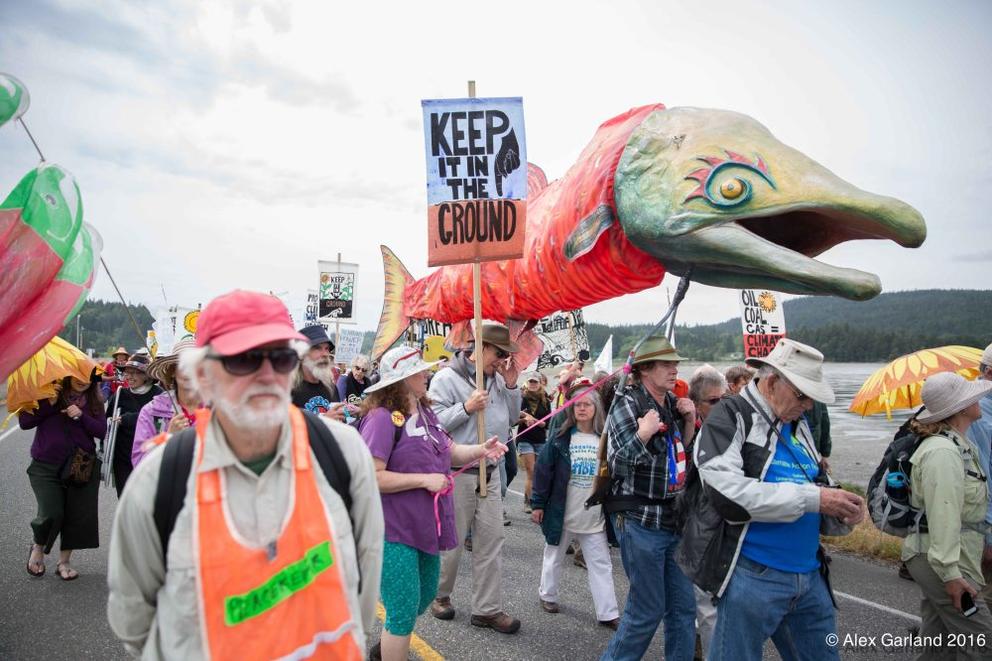Environmentalists are celebrating the recent news that Peter Goldmark, Washington State's public lands commissioner, decided against leasing state-owned land in Longview for Millennium Bulk Terminal’s proposed coal export facility. Many say it’s a fatal blow to Millennium’s plan to export up to 44 million metric tons of Powder River Basin coal each year. The flow would dwarf the roughly 1.7 million metric tons that’s shipped annually from the West Coast’s current biggest coal export facility in Long Beach, California.
This is a big development in its own right. But it could also be momentous in a larger narrative that has played out in the Pacific Northwest over the past few years. When it was first put on the table in 2011, Millennium was the first of six proposals for massive coal terminals in Washington and Oregon. These proposals spawned an environmental movement against fossil fuels that came to be known as the “Thin Green Line.” One by one, those proposals were knocked down — until Millennium was left the last one standing.
By denying Millennium the critical piece of land that it needs to build the facility, did Goldmark hand a final victory to those fighting along the Thin Green Line?
Not according to Bill Chapman, Millennium Bulk President and CEO. “The decision today has no effect on the project,” he said in a statement. “We look forward to permitting and operating a world-class port in Longview that will provide family wage jobs and tax revenues right where they are needed in Cowlitz County.”
What’s more, a new, pro-coal administration takes control in Washington, D.C. this month, and President-elect Trump’s pick to lead the Department of the Interior, Montana Rep. Ryan Zinke, has been big supporter of building export facilities in the Pacific Northwest in order to bring Montana’s carbon across the Pacific to Asian markets.
Still, Eric de Place, policy director at the Sightline Institute, a Seattle-based environmental think-tank, is skeptical of Chapman’s claims, and doubts that Zinke will be able to revive the proposals for mega-coal terminals in Washington. “They have run into obstacle after obstacle,” he told Crosscut. “Their finances are a wreck. All of their plans have either been radically delayed or simply denied.”
Many of these hinderances, he points out, have had less to do with government decisions or regulations than with changes in the markets abroad.
The reason these export terminals were ever in the hopper was that, as domestic demand for coal dwindled in favor of more affordable liquid natural gas, coal counties in Montana, Wyoming and Utah spiraled into economic devastation. About a decade ago, however, coal producers saw a way to regain some ground: Their product could still fetch a pretty price in Asia, if only they could get it there in large enough quantities.
And so major coal companies began to invest in the infrastructure they would need to transport their goods.
In the time since then, however, that global market has changed: Energy experts are speculating that China’s demand for coal peaked and is now on the decline. Meanwhile, major coal firms across the U.S. have declared bankruptcy — including Arch Coal, one of the two main investors of the Millennium Bulk Terminal, although it has since restructured and resumed business.
These factors, on top of the significant public pushback the proposed coal terminals received, don’t bode well for coal’s future, or for Trump’s ability to make good on his promises to put miners back to work.
“You have to squint really hard to come up with a situation where we have anything like that happening again,” de Place said.
But coal isn't the only fossil fuel that has been a part of this broader conversation. As the U.S. continues to increase its production of oil and gas in the next decade, it could flip from being a net energy importer to a net energy exporter, according to a report released January 5 by the Energy Information Administration. That would likely mean building more export facilities along our coasts, such as the proposed crude oil terminal at Gray’s Harbor. Should that proposal go through — and it may have a path forward to do so — it could become the largest oil export facility in North America, de Place said.
In other words, the Thin Green Line is indeed still a frontline. And the end of coal could really just be its beginning.



